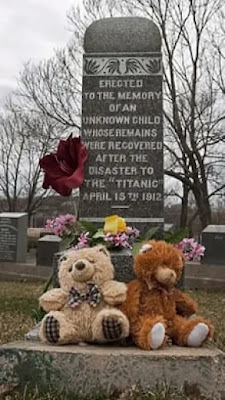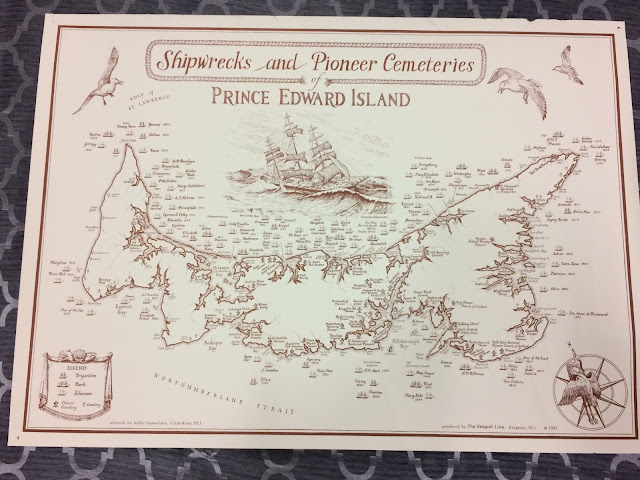Titanic: "we buried it here in Halifax"
On April 15, 1912 the Titanic sank. More then 1,500 passengers and crew died that night. Many went down with the ship, but for others, they were kept afloat by their life jackets. White Star Lines, the owners of the Titanic, chartered three from ships from Halifax and one from St. John's to recover as many bodies as they could. Halifax became the epicentre of the recovery effort.
 |
| Grave marker of The Unknown Child who perished in the disaster and buried at the Fairview Lawn Cemetery. This child, through genetic testing, was later identified as 19 month old Sidney Goodwin. |
Why not Newfoundland? Wasn't it closer?
So Newfoundland was closer to the sinking, but Halifax was easier to reach and had railway connections to other major cities which would make it easier to bring in resources, and perhaps more importantly, it made it easy for families to get to Halifax to identify their loved ones and to transport remains home if the families desired. Finally, Halifax also had more undertakers.
Ship #1 : Mackay-Bennet
The Mackay-Bennet was a cable ship owned by the Commercial Cable Company. Normally, the ship and crew would be laying and repairing the Commercial Cable Company's transatlantic undersea telegraph cables. Knowing this work would be unsettling, only crew who volunteered participated.
The ship carried 125 quickly made coffins and enough embalming fluid for 70 bodies. Knowing they would run out of embalming fluid, the ship also carried several tons of ice. Canvas and scrap iron weights were also aboard for burials at sea. The ship was manned by Captain Frederick Larnder, the volunteer crew, an embalmer, and a Protestant clergyman.
They reached the site on the evening of April 20th and they began the recovery at 6AM on the 21st. Lookouts stationed on the bridge and bow scanned the sea. Often, they found the bodies by seeing their white life preservers. According to Captain Larnder it looked like a "flock of sea gulls." As crew got the remains aboard, the bodies and personal affects were numbered and examined by the embalmers.
 |
| Mackay-Bennet recovering an overturned lifeboat |
The crew then had to decide to either transport the remains to Halifax or bury them at sea. There is no record of how crew made these decisions but it is assumed the following played role:
1. If the remains were identifiable
2. The physical condition of the remains
3. Perceived social class
The ship spent 13 days at sea and recovered the remains of 306 people. 190 were taken to Halifax and 116 were buried at sea.
Ship #2 Minia
White Star Line charted the Minia, also a cable ship, from the Western Union, captained by William deCarteret. Like the Mackay-Bennet, it carried 150 coffins when it departed Halifax on April 22nd in addition to 20 tons of ice and 15 tons of scrap iron. It reached the search area on April 26th. By then, bad weather was making the search harder and many remains had been swept away from the site by the Gulf Stream. Some were found up to 240km away.
After a week, the Minia only found the remains of 17 men. Two were buried at sea and the rest were transported to Halifax.
When the Minia returned to Halifax, the unused coffins and embalming fluid were moved to the steamship Montgagny.
Ship #3 Montgagny
The Montgagny was a lighthouse supply and buoy tender owned by the Canadian Government and operated by the Department of Marine and Fisheries. Peter Johnson and Francois-Xavier Pouliot co-captained the vessel. On May 6th, they left Halifax with two undertakers and both a Protestant and Catholic clergyman.
They recovered the remains of four individuals. On May 9th, they buried the first one at sea and the remaining three were delivered to Louisburg, on Cape Breton Island, on May 13, and were shipped to Halifax. The Montgagny returned to the search area and did a thorough search, but found no more remains. The fourth ship, Algerine, arrived on May 19th and the Montgagny returned to Halifax on May 23.
Ship #4 Algine
The Algine would be the last vessel chartered by White Star Line. Algine was a civilian cargo and passenger ship and part-time sealer. The Algine left St. John's on May 16th. It was captained by John Jackman and carried two undertakers. When it arrived at the search zone, it took over for the Montgagny and continued the search for three weeks. In that time, they only found the body of a saloon steward. His remains were taken back to St. John's on June 6th before being moved to the Florizel for transport to Halifax.
Other Ships
Ships passing through the area also found remains. The Carpathia, who got the distress call, found the lifeboats. The lifeboats contained 713 survivors and the remains of three people. One survivor also died aboard the Carpathia. These four people were buried at sea. Other passing ships also found the remains of five people. On June 8th, a passing ship found the last of the recovered remains.
 |
| Standard Titanic lifeboat (no. 6) rescued by the Carpathia |
The Titanic carried 2,228 passengers and crew. 1,518 people lost their lives, only 328 were recovered.
Of the 328 recovered remains, 209 were taken to Halifax for burial or transport elsewhere. The rest were buried at sea. 105 of these remains were laid to rest in three Halifax cemeteries:
1. Fairview Lawn Cemetery, 3720 Windsor Street, Halifax
2. Mount Olivet Cemetery, Mumford Road, between Joseph Howe Drive and Olivet Street, Halifax
3. Baron de Hirsch Cemetery, located within the Fairview Lawn Cemetery
White Star Line provided small, standardized headstones however, families could pay for more elaborate ones.
 |
| Fairview Lawn Cemetery, June 2014. |
The Maritime Museum of the Atlantic on the Halifax waterfront has a permanent Titanic display. When I visited in early 2019, one of the exhibits was a small tank of water. The water was the temperature it was believed to be the night the Titanic sank.
According to The Associated Press, religious leaders and politicians asked Halifax residence to stay away from the harbour to keep it from becoming a "three-ring circus." This was also done to respect the remains and their families. People knew this was a somber event and many had known or knew of people who were aboard the Titanic. For the most part, people respected this and remained away.
While reporters, including those from Toronto, Montreal, Boston, and New York, were given a pass to a holding wharf where they could see the casket's being unloaded, photographs were forbidden, and the photographer was stopped if they attempted it. It is why there are no pictures of the casket's being unloaded.
According to Alan Ruffman, a Halifax local and Titanic researcher, the story of the Titanic is a part of Halifax. "While they built it in Belfast, sank it in the Atlantic, we buried it here in Halifax."
Boileau, John. "Halifax and Titanic." The Canadian Encyclopedia. May 16, 2022. https://www.thecanadianencyclopedia.ca/en/article/halifax-and-titanic
"Nova Scotia's Titanic Connection." Nova Scotia. https://www.novascotia.com/trip-ideas/stories/nova-scotia-titanic-connection
The Associated Press. "Halifax had grim role in Titanic tragedy." CBC News. April 4, 2012. https://www.cbc.ca/news/world/halifax-had-grim-role-in-titanic-tragedy-1.1281806


Comments
Post a Comment